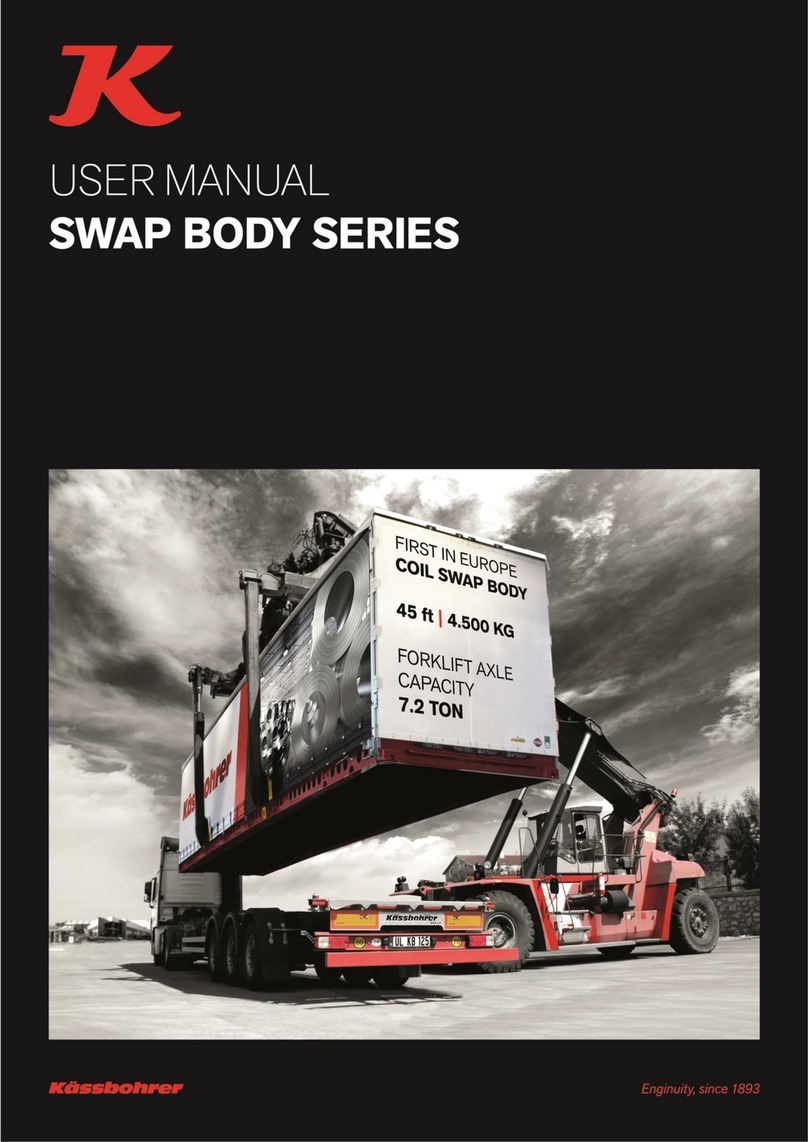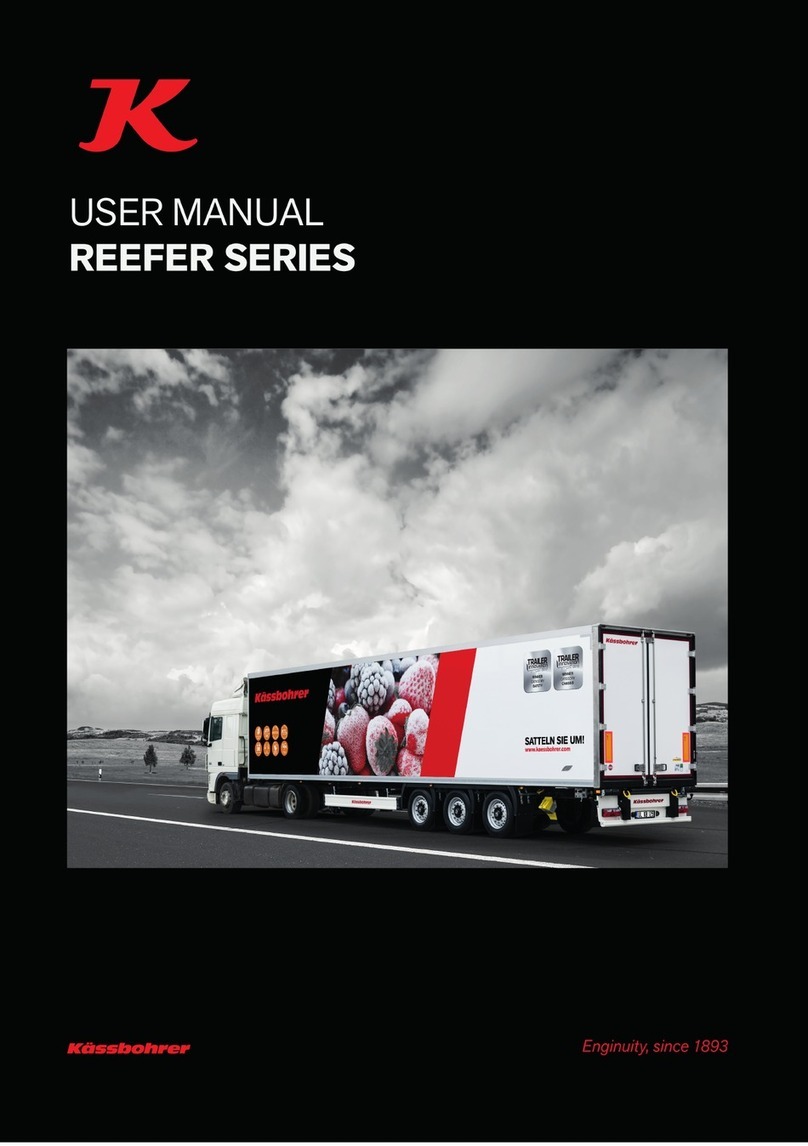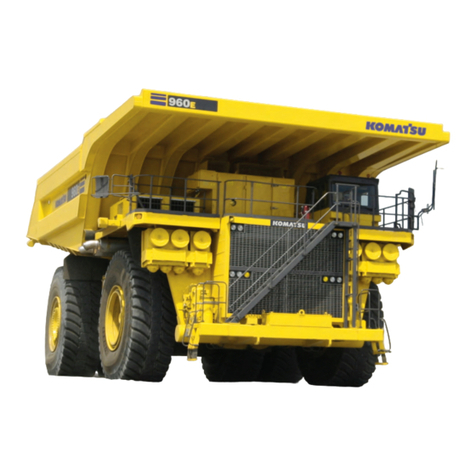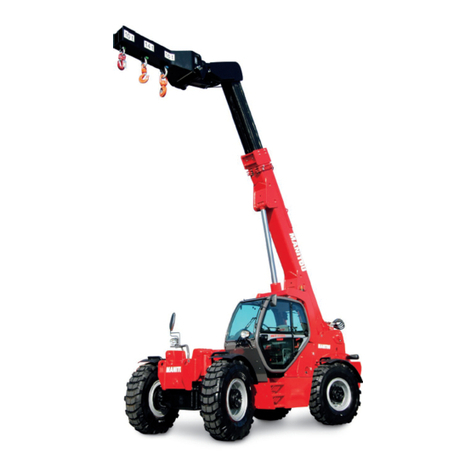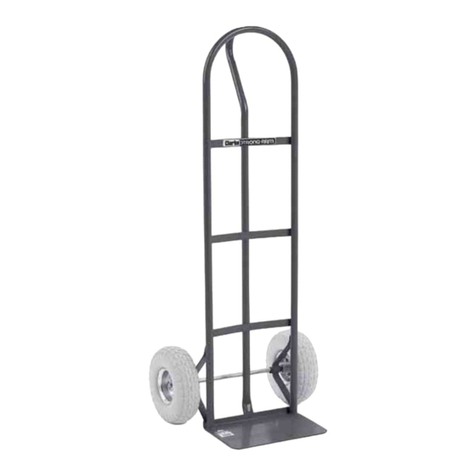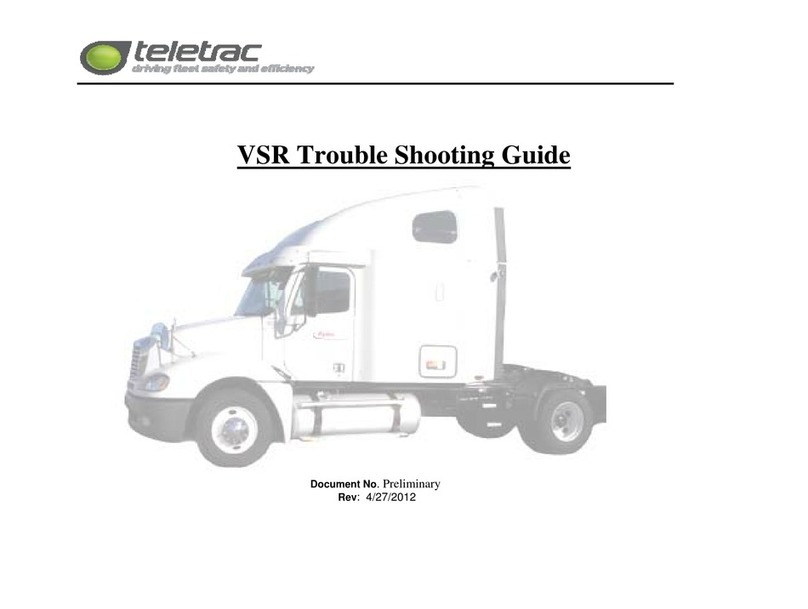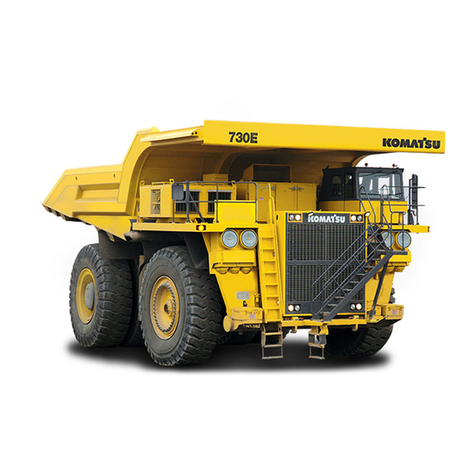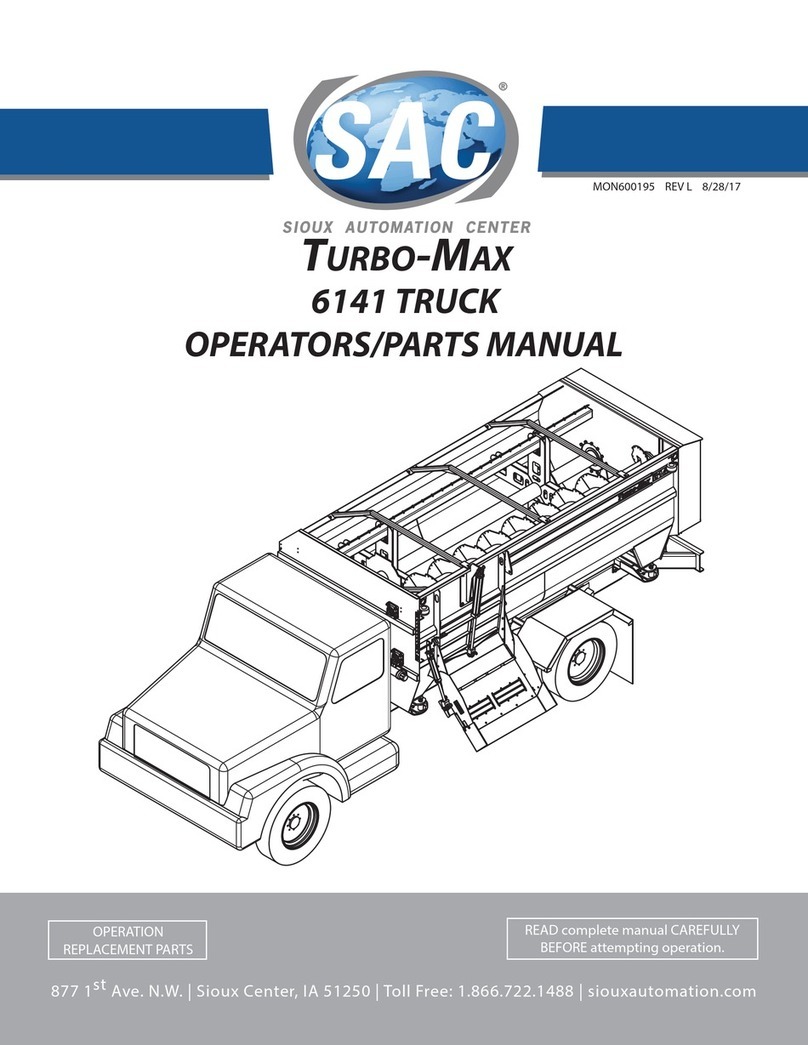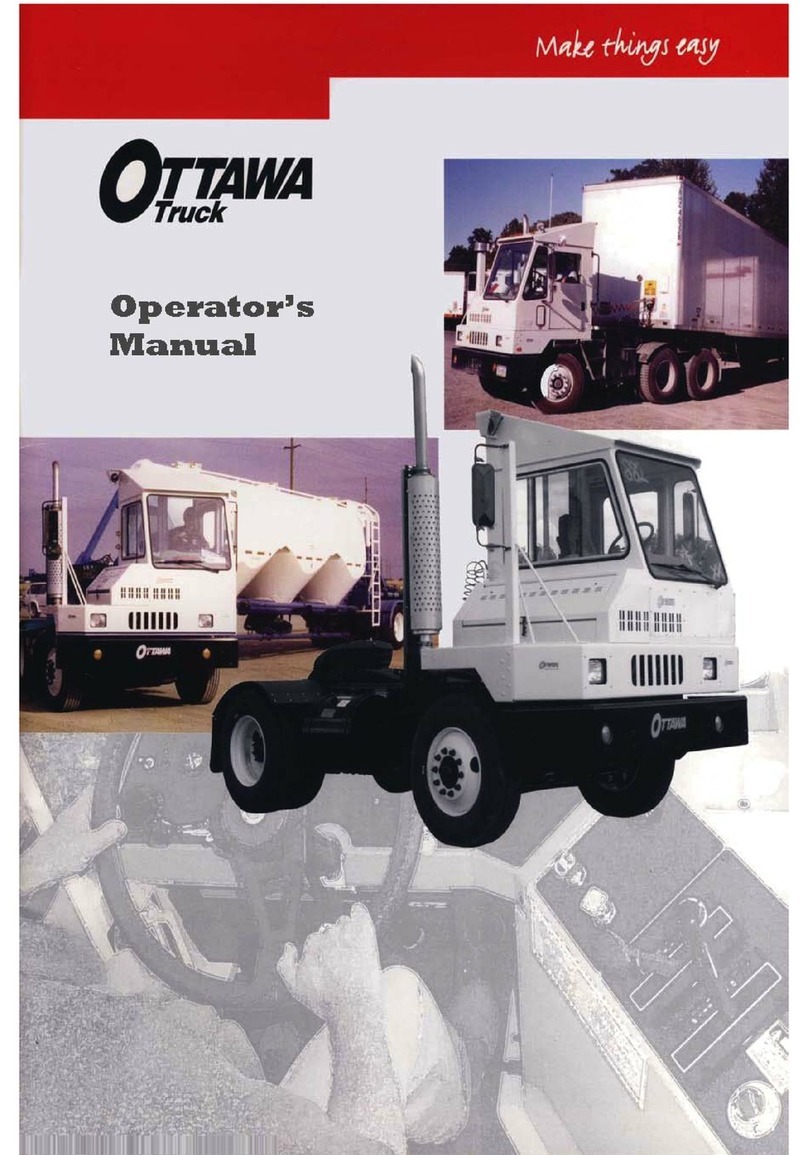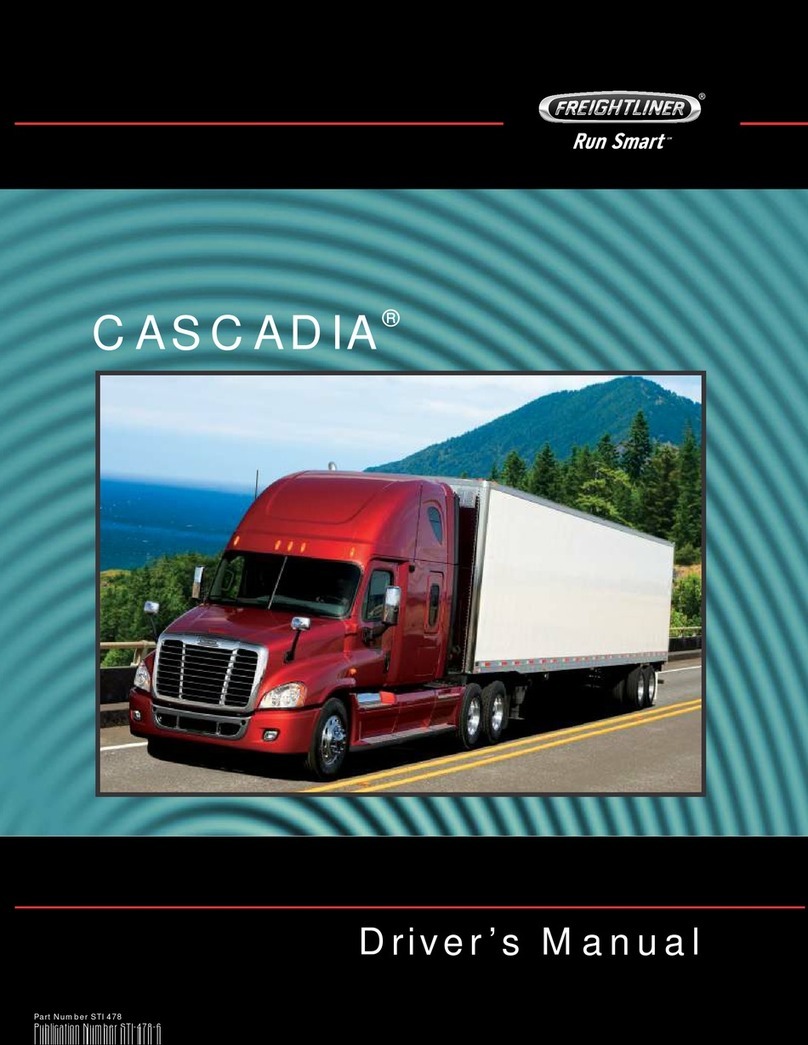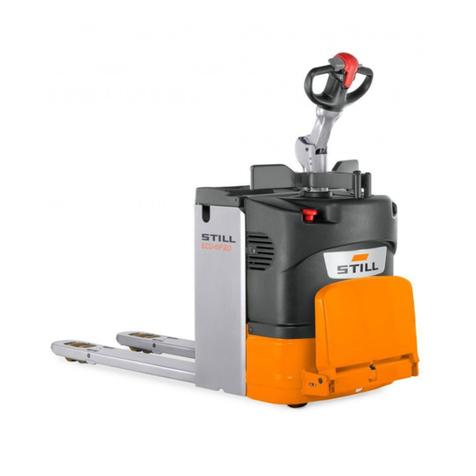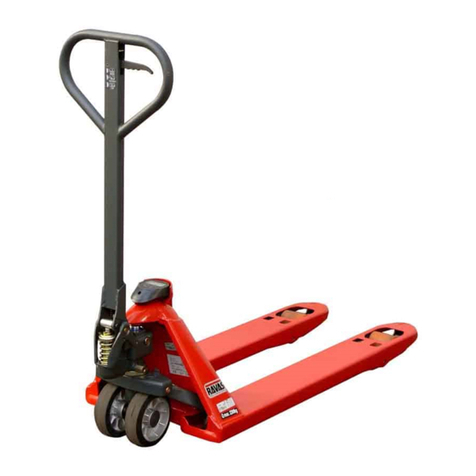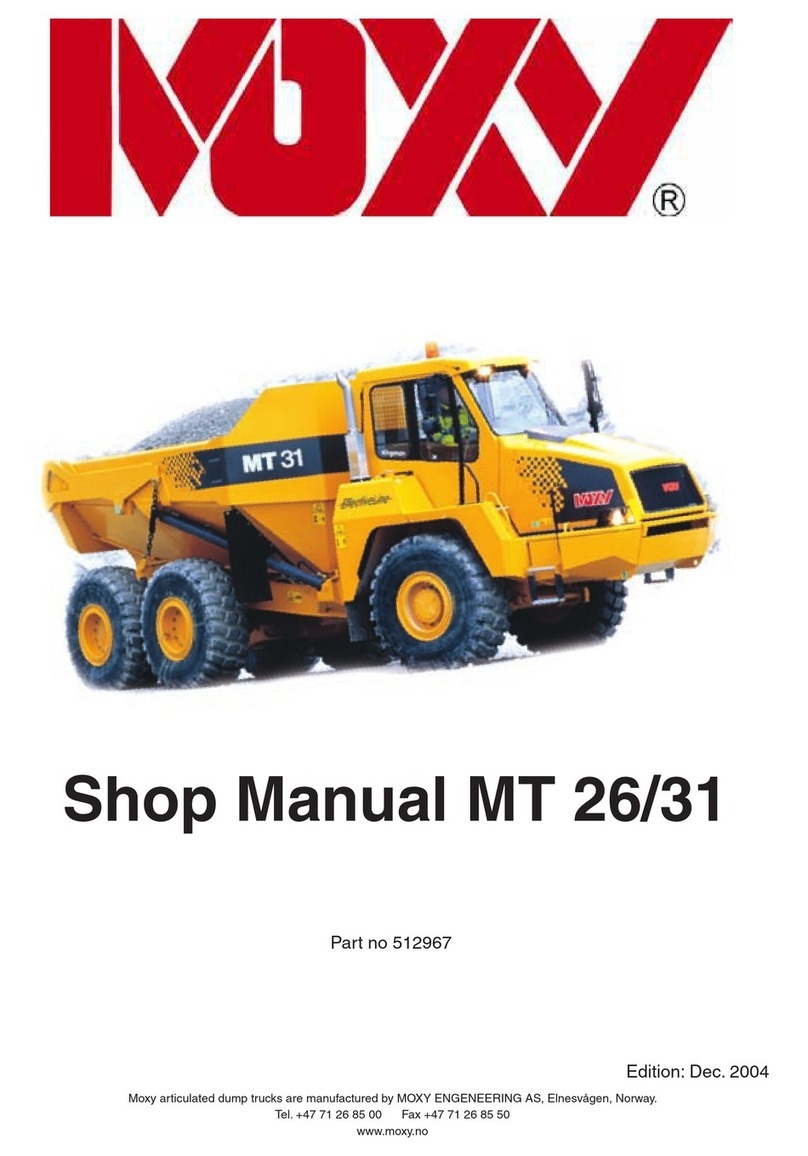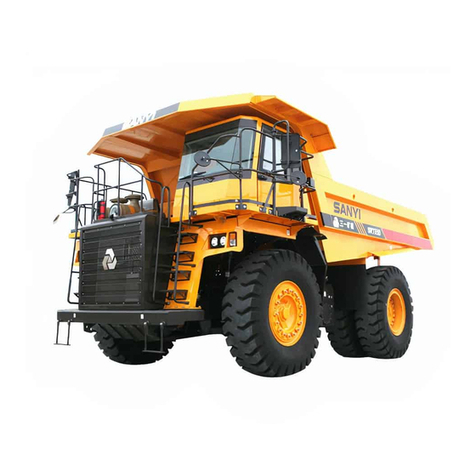Kässbohrer TANKER Series User manual


IInnddeexx
1. GENERAL INFORMATION AND SAFETY INSTRUCTIONS
1.1. About the User Manual .............................................................9
1.2. Meanings of Symbols Used in User Manual..............................9
1.3. Personal Protective Equipments...............................................10
1.4. Terms of Use and Safety Information ......................................11
1.5. Possible Hazards ......................................................................11
1.6. Danger Areas............................................................................12
1.7. Weather Conditions ..................................................................13
2. MAIN INFORMATIONS
2.1. Vehicle Identification Plate ......................................................14
2.2. Brake Data Plate.......................................................................14
2.3. VIN (Chassis) Numbers ...........................................................15
2.4. Warranty and Responsibility ....................................................15
3. TRAILER RUNNING GEAR AND USAGE INSTRUCTIONS
3.1. Brake System ...........................................................................16
3.1.1. Air Couplings ....................................................................16
3.1.2. Compressed Air Tanks ......................................................19
3.1.3. EBS Socket........................................................................19
3.1.4. Rollover Stability Support (RSS)......................................20
3.1.5. PREV (Park Release Emergency Valve)...........................20
3.1.6. Brake Chambers ................................................................21
3.2. Suspension System...................................................................23
3.2.1. Manuel Control .................................................................23
3.2.2. Auto Reset.........................................................................23
3.2.3. Electronic Controlled Air Suspension (ECAS).................23
3.3. Electrical System......................................................................24
3.3.1. 15 Pin Socket.....................................................................24
3.3.2. 2x7 Pin Socket...................................................................25
3.3.3. Light System .....................................................................26
3.4. King Pin ...................................................................................27
3.5. Landing Gear............................................................................27
3.5.1. Front Landing Gear’s Working Principle..........................27
3.6. Side Protection Equipment (Underrun Protection) ..................29
3.7. Semi-Trailer Axle System ........................................................29
3.7.1. Self-Steering Axles ...........................................................30
3.7.2. Axle Lifting.......................................................................31

3.7.3. Hubodometer.....................................................................32
3.8. Tires .........................................................................................32
3.9. Spare Wheel Holder .................................................................33
3.9.1. Crane Type Spare Wheel Holder.......................................33
3.9.2. Basket Type Spare Wheel Holder .....................................34
3.10. Mudguards..............................................................................34
3.11. Wheel Chock ..........................................................................34
3.11.1. Pin Type Wheel Chock Holder........................................35
3.11.2. Pocket Type Wheel Chock Holder ..................................35
3.12. Boxes and Storage Units ........................................................35
3.12.1. Stainless Steel Toolbox ...................................................35
3.12.2. Steel Food Box................................................................36
3.12.3. Plastic Toolbox................................................................37
3.12.4. Fire Extinguisher Cabinet ...............................................37
3.12.5. Water Tank ......................................................................38
3.12.6. Document Box ................................................................38
3.12.7. Fuel Tank.........................................................................38
3.12.8. Armature Box..................................................................38
3.12.9. Armature Box Cover .......................................................39
3.12.10. Hose Carriers and Hose Holders ...................................39
3.12.11. Working Lamp...............................................................40
3.12.12. Rear Bumper (Rear Protection Equipment) ..................41
3.12.13. Ladder, Walkway and Handrails ...................................41
3.12.14. Lubrication System .......................................................44
3.12.15. Grounding Pins..............................................................44
3.13. Warning Signs ........................................................................44
4. UPPERSTRUCTURE COMPONENTS AND USE
4.1. Bitumen (Tar) Tanker ..............................................................45
4.1.1. Overview of Tank Components ........................................45
4.1.2. Tank...................................................................................46
4.1.3. Isolation Coating ...............................................................46
4.1.4. Manhole Cover..................................................................46
4.1.5. Pressure Safety Valve........................................................47
4.1.6. Ventilation Valves..............................................................47
4.1.7. Vacuum Valve....................................................................48
4.1.8. Side Air Line .....................................................................48
4.1.9. Jet Air Line........................................................................48
4.1.10. Top Air Line....................................................................49
4.1.11. Bottom Valve...................................................................49

4.1.12. Safety Valve ....................................................................50
4.1.13. Remote Control System ..................................................51
4.1.14. Sampling Valve ...............................................................56
4.1.15. Thermometer ...................................................................56
4.1.16. Manometer ......................................................................57
4.1.17. Heating Line....................................................................58
4.1.18. Warning Signs On the Tank ............................................59
4.2. Chemical Tanker ......................................................................59
4.2.1. Overview of Tank Components ........................................59
4.2.2. Tank...................................................................................61
4.2.3. Isolation Coating ...............................................................61
4.2.4. Manhole Cover..................................................................61
4.2.5. Pressure Safety Valve........................................................62
4.2.6. Vacuum Valve....................................................................62
4.2.7. Blast Valve ........................................................................63
4.2.8. Jet Air Line........................................................................63
4.2.9. Top Air Line ......................................................................63
4.2.10. Bottom Valve...................................................................64
4.2.11. Safety Valve.....................................................................65
4.2.12. Sampling Valve ...............................................................66
4.2.13. Thermometer ...................................................................66
4.2.14. Manometer ......................................................................66
4.2.15. Drain Valves ....................................................................66
4.2.16. Heating Line....................................................................67
4.2.17. Warning Signs On the Tank ............................................68
4.3. Food Tanker .............................................................................69
4.3.1. Overview of Tank Components ........................................69
4.3.2. Tank...................................................................................70
4.3.3. Isolation Coating ...............................................................70
4.3.4. Manhole Cover..................................................................70
4.3.5. Breather Valve...................................................................71
4.3.6. Cleaning Line ....................................................................71
4.3.7. Bottom Valve.....................................................................72
4.3.8. Discharge Valves...............................................................72
4.3.9. Thermometer .....................................................................73
4.3.10. Drain Valves ....................................................................73
4.4. Waste Tanker ............................................................................74
4.4.1. Overview of Tank Components ........................................74
4.4.2. Tank...................................................................................76

4.4.3. Filling Manhole.................................................................76
4.4.4. 6" Pneumatic Control Gate Valve For Ventilation ............76
4.4.5. Safety Valve ......................................................................76
4.4.6. Vacuum Valve....................................................................76
4.4.7. Pneumatic Valve for Tank Ventilation...............................77
4.4.8. Pneumatic Overfill Protection For Stop The Pump ..........77
4.4.9. Filling Funnel ....................................................................77
4.4.10. Filling Funnel 8’’ Pneumatic Control Gate Valve ..........77
4.4.11. Tank Level Indicator .......................................................77
4.4.12. 6" Manual Control Gate Valve ........................................78
4.4.13. Perrot Coupling ...............................................................78
4.4.14. Turning Joint ...................................................................78
4.4.15. Pump ...............................................................................78
4.4.16. 3 Way Ball Valve.............................................................78
4.4.17. Discharge Pump Outlet Line...........................................79
4.4.18. Tank Mixing Pump Inlet Line .........................................79
4.4.19. Discharge Pump Inlet Line..............................................79
4.4.20. Tank Mixing Pump Outlet Line ......................................79
4.4.21. Sampling Valve ...............................................................79
4.4.22. Perrot Coupling Cover ....................................................80
4.4.23. Hydraulic Control Lever .................................................80
4.4.24. Hydraulic Pressure Gauge...............................................80
4.4.25. Pneumatic Valve..............................................................80
4.4.26. Filling Funnel Valve........................................................81
4.4.27. Pneumatic Manometer ....................................................81
4.4.28. Pneumatic Valve for Tank Ventilation.............................81
4.4.29. Central Lubrication System.............................................81
4.4.30. Central Lubrication Electronic Counter System .............82
4.4.31. Central Lubrication On / Off Button ...............................82
4.4.32. Hydraulic Quick Coupling ..............................................82
5. TRANSPORTATION PROCESS
5.1. Pre-Driving Checks..................................................................83
5.2. Semi-Trailer and Tractor Coupling ..........................................83
5.3. Cautions During the Parking and Stopping..............................84
5.4. Reversing Camera ....................................................................84
5.5. Important Technical Considerations ........................................85
5.5.1. Fire Extinguisher...............................................................85
5.5.2. Wheel Chocks ...................................................................85
5.5.3. Modifications on the Trailer..............................................85

5.5.4. Air Leakage.......................................................................85
5.5.5. Oils ....................................................................................85
5.5.6. Welding .............................................................................86
5.5.7. Spare Wheels.....................................................................86
5.5.8. Considerations For the Environment ................................86
5.6. Cleaning of the Vehicle ............................................................87
6. TRANSPORTATION SOLUTION
6.1. Dangerous Goods Transportation (ADR) ...............................89
6.2. Transportation Compliant with ATP Legislation .....................89
6.3. Chemical Substance Transportation.........................................89
7. LOADING AND LOAD SECURITY
7.1. Loading and Discharging of Bitumen (Tar) Tanker .................91
7.1.1. Safety Instructions.............................................................91
7.1.2. Load Distribution and Load Limits of Tractor-Semi-trailer
Combination ..........................................................................91
7.1.3. Loading Preparation ..........................................................92
7.1.4. Loading .............................................................................92
7.1.5. Discharge...........................................................................94
7.2. Loading and Discharging of Chemical Tanker ........................97
7.2.1. Safety Instructions.............................................................97
7.2.2. Load Distribution and Load Limits of Tractor-Semi-trailer
Combination...........................................................................99
7.2.3. Loading Preparation ..........................................................99
7.2.4. Loading ...........................................................................100
7.2.5. Discharge.........................................................................101
7.2.6. Warnings for Filling and Discharging Operations ..........105
7.2.7. Checks After Loading and Unloading.............................106
7.3. Loading and Discharging of Food Tankers ............................106
7.3.1. Safety Instructions...........................................................106
7.3.2. Load Distribution and Load Limits of Tractor-Semi-trailer
Combination.........................................................................107
7.3.3. Loading Preparation ........................................................107
7.3.4. Loading ...........................................................................108
7.3.5. Discharge.........................................................................108
7.3.6. Warnings for Filling and Discharging Operations ..........111
7.3.7. Checks After Loading and Unloading.............................111
7.4. Loading and Discharging of Waste Tankers ..........................111
7.4.1. Safety Instructions...........................................................111

7.4.2. Load Distribution and Load Limits of Tractor-Semi-trailer
Combination.........................................................................112
7.4.3. Loading ...........................................................................113
7.4.4. Discharge.........................................................................114
7.4.5. Warnings for Filling and Discharging Operations ..........118
7.4.6. Checks After Loading and Unloading.............................118
8. INSPECTION AND MAINTENANCE
8.1. Safety Instructions..................................................................119
8.2. Main Principles ......................................................................119
8.3. Checks to Be Performed Of The Time of the Delivery .........119
8.4. Manhole Covers .....................................................................119
8.5. Cataphoresis Coating .............................................................120
8.6. Galvanized Coating ...............................................................120
8.7. Periodic Maintenance and Controls .......................................120
8.8. Important Warning! ................................................................120
8.9. Trouble Shooting....................................................................121
8.9.1. Safety Instructions...........................................................121
8.9.2. Spare Tire Replacement ..................................................121

FOREWORD
First of all, thank you for choosing us for your new vehicle investment.
Your vehicle is manufactured with the latest production technologies to the highest quality
standards and equipped with the best safety and efficiency features.
You can find detailed information about the accessories, equipment and hardware that might
be in your vehicle in this manual. The defined options in this manual can vary according to
the vehicle specs.
Important information on how you can use your vehicle is explained in this user manual,
please be sure that you review and understand the content. We suggest keeping this user
manual available in your vehicle at all times. This information is specified in the product’s
user manual. We recommend you read this operating manual thoroughly to get the most out
of your vehicle.
* Owing to the developments in product research, the manufacturer reserves the right to
make any changes in the product, without any prior notice. The publication rights of this doc-
umentation belong to the manufacturer.

9 / 123
1. GENERAL INFORMATION AND
SAFETY INSTRUCTIONS
1.1. About the User Manual
The usage and operation information
given in this manual is prepared to make
sure the vehicle is used in compliance
with its purpose and as desired.
The instructions here contain important
recommendations to perform your oper-
ations safely, completely, and in the most
efficient manner. Complying with these
instructions, warnings and recommenda-
tions will prevent accidents, decrease
down-time / repair costs, and make sure
you use your vehicle safely, reliably and
problem-free.
Please read the operating instructions in
this manual carefully and completely.
The manufacturer is not liable for the
damages and deficiencies caused by the
failure to comply with these instructions.
The instructions herein must be sup-
ported by local laws, rules and regula-
tions. Please comply with these
instructions to prevent accidents and
protect your surroundings and the
environment.
Any usage of transportation that goes
beyond the use in accordance with the
rules will be considered improper use.
Transportation of the following is not
allowed:
•Carrying people and live animals
•Transportations that need to be car-
ried according to special instruc-
tions, e.g., dangerous good
transportations
•Transportation of unsecured goods
•Transportation of materials that are
dangerous due to their properties or
that need to be carried with special
equipment
•Exceeding technically and legally
permissible weights of the axles or
king pin load
•Exceeding of the maximum vehicle
speed
•Exceeding the permissible length,
width and height
•Unapproved parts like tires, acces-
sories, spare parts and etc. by the
manufacturer
The manufacturershall not accept any
responsibility for the problems and faults
that occurs that are not in compliance
with the purpose of the vehicle’s usage.
All the risks of this issue belong to the
customer.
It is necessary to keep the
user manual available on the
vehicle at all times.
The vehicle can be equipped
with a lot of different options.
The standard or optional fea-
tures will be explained in the
manual. Some options may
not be available for your
vehicle.
Adhere strictly to the opera-
ting instructions when using
your vehicle. When problems
occur which can lead to dan-
gerous consequences, con-
tact the service centre
immediately.
1.2. Meanings of Symbols Used in
User Manual
Several warnings are available in this
manual to ensure maximum safety when
using your vehicle. Each warning is indi-
cated by a special symbol. These sym-
bols and their meanings are as follows.

The information specified by
this warning symbol is very
important for health and hu-
man safety. When the given in-
formation is ignored, serious
damage, injuries and even
death may occur.
This symbol specified in this
manual indicates that critical
accidents may occur when the
instructions do not comply.
This symbol is used when ad-
ditional information is
required.
This symbol is used when
chemicals and other substan-
ces can be disposed of with
precautions that will not harm
the environment.
1.3. Personal Protective Equipments
Personal protective equipments serves
the purpose of preventing injuries and
are prevents injuries and are determined
by regional regulations depending on the
load carried.
People who will work or perform opera-
tions on the vehicle must wear proper
and appropriate protective clothing.
•Depending on the load to be carried,
the eyes, ears, body, and respiratory
tract must be protected with the rel-
evant protective equipment.
•As a rule, gloves and work shoes
are always used.
It is obligatory to use approp-
riate personal protective
equipment during the
operations.
Long hair is particularly dan-
gerous when working on the
vehicle, regardless of whether
it is loose or tied up, and it
should be protected properly
to avoid tangling.
Wearing a tie, necklace and/or
dangling jewelry when wor-
king on the vehicle is strictly
prohibited. They may get
caught in moving parts or
mechanisms and cause inju-
ries and even death.
Protective Gloves
During the operation, protecti-
ve gloves must be used. Plea-
se make sure you are using
the correct type of gloves
when you are working with
hot parts or chemicals.
Gloves should fit snugly. Ot-
herwise, there is a risk of them
getting caught in moving
parts or mechanisms.
Protective Cloth
While working on the vehicle,
appropriate overalls must be
worn.
•Overalls should not have pleats,
buttons or external pockets and their
closure system should be made in
such a way that they can be opened
as soon as possible in case of an
emergency.
•Interior pockets should have fasten-
ings to close them up. Cuffs should
be adjusted to fit the wrist.
Protective Helmets

11 / 123
When working around the ve-
hicle, a lightweight helmet
approved by an accredited
institution should be worn.
Protective Ear Plugs
A hearing protective device
(headsets or ear plugs) should
always be used around self-
propelled vehicles.
Protective Goggles
Protective goggles should be
worn during all maintenance
operations.
Protective Mask
Appropriate protective masks
should be used when working
with substances that are dan-
gerous to breathe or in dusty
environments.
1.4. Terms of Use and Safety
Information
It is necessary to keep the warranty, op-
erating and maintenance manual and
other documentation about the vehicle
available on the vehicle at all times.
To prevent possible accidents and envi-
ronmental pollution, follow the operating
instructions and binding regulations.
•Pay attention to the safety and
warning signs placed on your
vehicle.
•Always keep these safety and warn-
ing signs completely visible.
•Make sure that the load carrier is se-
cured properly.
•In case of any dangerous condition
in the operation of safety, stop your
vehicle immediately and inform the
authorized people or institutions.
•Do not modify anything on the ve-
hicle without a written manufac-
turer’s approval. Your vehicles
guarantee terms do not cover unap-
proved modifications.
•The spare parts must meet the tech-
nical requirements set forth by the
manufacturer company. Only the
original spare part/parts meet their
requirements.
1.5. Possible Hazards
Your tanker vehicle is manufactured with latest technology and appropriate to widely known
technical safety rules. Nevertheless the risk of injury even death for driver and other persons
and the risk of damage for vehicle and surrounding objects still exist.
A summary of dangers while operating on tanker. vehicle are described below. It is recom-
mended to read these dangers carefully and completely.
Danger Source Consequences
Contact with load durind load-
ing, unloading or cleaning
Risk of injury or poisining!
Breathing load or contact with skin or eyes may re-
sult in injury.
•Avoid physical contact with load and avoid
breathing vapour resulted from load.
•Never loosen connection hoses during
loading or unloading.

•Wear protective clothes against load and
hazards that may arise from load.
•If the load causes an injury, contact to ma-
terial safety document for necessary emer-
gency measures.
Rubbing of load against tank
walls and connections
Risk of fire and explosion!
If the identical potential conductor (grounding pins)
is not connected, statical load may cause sparks
and explosions.
•Connect grounding pins during loading,
unloading and cleaning.
Entering into the tank Risk of fatal injury!
Entering into the tank after the journey for cleaning,
inspection and maintenance purposes will lead to
serious health risks.
•Do not enter into the tank when not
necessary.
•Conduct the necessary gas measurements
appropriately before entering into the tank.
1.6. Danger Areas
In this section, dangerous areas on and around the tanker vehicle and dangers that may oc-
cur are briefly described.
Danger Area Aciton to be performed
Between the tractor and tanker
vehicle
Risk of stucking persons during fastening or unfas-
tening tractor and tanker vehicle.
•People should be far off from the danger
area.

13 / 123
Around tanker vehicle Presenting unauthorized persons around the ve-
hicle during loading and unloading is dangerous for
you and other persons.
•Ensure the unauthorized persons are out-
side the danger area.
All sides of not connected tanker
vehicle
In some cases not connected tanker can suddenly
fall down and injure people.
•For this reason never stay around the tank-
er not connected to tractor.
•Tanker should be in safe condition for
maintenance operations.
1.7. Weather Conditions
Depending on weather conditions, make sure the vehicle is free from snow and ice at tem-
peratures below zero. Clean the snow or ice in the vehicle. Do not put yourself in danger dur-
ing this process.

2. MAIN INFORMATIONS
There are vehicle identification stickers
on the vehicle.
2.1. Vehicle Identification Plate
Vehicle identification plate is located on
the right side of the vehicle.
You may find the following information’s
on this plate:
1- Type approval number
2- VIN number
3- Technical total capacity
4- Technical king pin capacity
5- Technical an axle capacity
6- Technical total axle capacity
7- Nationally approved total capacity
8- Nationally approved king pin capacity
9- Nationally approved an axle capacity
10- Nationally approved total axle
capacity
11- Vehicle Type
Vehicle identification plate
In addition, since the Stainless Chemical
and Bitumen (Tar) tankers are pressur-
ized/non-pressurized vessels carrying
dangerous goods, they are in compli-
ance with ADR and the seal of approval
by the 3rd organization is on this plate.
Tested gross volumes appear on this
plate.
2.2. Brake Data Plate
There is a brake data plate (2) on the ve-
hicle which is equipped with an EBS
system.
You may see this information on this
plate.
EBS Plate
1 Empty vehicle (without load)
2 Loaded vehicle
3 Axle lifting
4 Brake chamber data’s
5 References
6 Driving height
7 Pin positions
8 IN/OUT-Connections

15 / 123
2.3. VIN (Chassis) Numbers
The VIN (chassis) number is located on
the right side of the vehicle and marked
with a different color than the chassis
color.
1- Chassis plate
2- VIN Number
3- ADR plate
4- Brake plate
2.4. Warranty and Responsibility
Our trailers, semi-trailers and truck on-
board applications are manufactured in
compliance with regulations and our
quality standards. It is necessary to per-
form the maintenance to ensure our
products always operate in the most effi-
cient manner in compliance with our lat-
est directives and maintenance
programs. The warranty starting date is
the date that the vehicle is delivered to
the customer.
The performance of maintenance and re-
pair/servicing of the vehicle with the use
of original spare parts by authorized
service shall assure the client’s warranty
rights. This warranty is based upon the
usage and maintenance conditions de-
scribed herein and in the warranty book.
Thus, it is important to read and under-
stand this operation manual and war-
ranty book.
It is necessary to keep the warranty, al-
ways operating and maintenance man-
ual available on the vehicle to allow
authorized service performing the servic-
ing to see the warranty conditions and
maintenance records. In the repairs
made during the warranty period, the au-
thorized service performing the repair
will demand this. Purchasing one trailer
or semi-trailer is an important invest-
ment. For the highest return on your in-
vestment, it is necessary to comply with
the manufacturer’s procedures and rec-
ommendations during the operation peri-
od of the vehicle. The information
provided by the client/driver related to
the warranty written in this manual shall
be kept within our database.

3. TRAILER RUNNING GEAR AND USAGE INSTRUCTIONS
1-2 Brake/Electric Connections
3 King Pin
4 Landing Legs
5 Side Protection
6 Wheel Chocks
7 Air Tank
8 Mudguard
9 Tire
10 Toolbox
11 Fire Extinguisher Box
12 Bumper
3.1. Brake System
3.1.1. Air Couplings
The main connection between the truck
and trailers is air couplings.
Generally, 3 different types of air cou-
plings are used in the trailers. These 3
types of air couplings have the same
function but with different shapes and
connections. There are 2 different air
supply lines in the system.
Brake Line (Yellow)
Supply Line (Red)
Service Line: Pneumatically air hose
which will feeds the brake line.
Supply Line: Pneumatically air hose
which will feeds the air tanks and trailer
According to the type of vehicle, your ve-
hicle can be equipped with one or two
different types of air couplings.
•Standard Couplings (Palm)
•Duomatic Coupling
•C (UK) Couplings

17 / 123
If your vehicle is equipped
with 2 different types of coup-
lings, you must use only one
type at the same time.
When the couplings are
mounting/demounting, the
parking brake of the truck and
trailer must be engaged.
If the brake parameters are
modified, your vehicle's brake
calculation might be non-sui-
table for regulations. Only aut-
horized services must service
to the EBS modulator.
Only authorized services and
personnel should make servi-
ce operations for the brake
system.
There might be test points on the chassis
or above the air couplings. When you re-
move the test points rubber protection
parts and push the points you can check
the air pres-sure on the brake lines.
Test point
Palm coupling with a test point
3.1.1.1. Mounting of Standard (Palm)
Couplings
Couplings
•Slightly slide plastic covers to the
upper side. Slide plastic covers to
upper side.
•Be sure that sealing surfaces are
clean and durable. If necessary,
clean/change the air coupling.
•The coupling which comes from the
truck should be pushed slightly from
the upper side to the lower side and
connect the coupling. Be sure that
couplings are matched correctly.
•First mount service line yellow (1).
•Mount supply line red (2).
3.1.1.2. Demounting of Standard
(Palm) Couplings
•The coupling which comes from the
truck should be pushed slightly from
the lower side to the upper side and
demount the coupling.

•First demount the supply line red
(2).
•Demount the service line yellow (1).
•Slightly slide plastic covers to the
lower side and close the plastic
covers.
Closing the coupling
Driving with a non-suitable air
connection is dangerous and
forbidden.
Using damaged air supply
parts can cause serious ha-
zards. Torn or damaged comp-
ressed air connectors reduce
the vehicle's braking
performance.
3.1.1.3. Mounting of C (UK) Couplings
Mounting the C (UK) Couplings
•Be sure that sealing surfaces are
clean and durable.If necessary,
clean/change the air coupling.
•First mount service line yellow (1).
•Mount supply line red (2).
•Be sure that couplings are matched
correctly.
3.1.1.4. Demounting of C (UK)
Couplings
•Push the latch from front to back
side on the C couplings and
remove.
•First demount the supply line red
(2).
•Demount the service line yellow (1).
The coupling filters have to be
clean regularly.
3.1.1.5. Mounting of Duomatic
Coupling
Duomatic Coupling Connection
•Be sure that sealing surfaces are
clean and durable.If necessary,
clean/change the air coupling.
•Push the arm and mount the cou-
pling (1).
The coupling filters must be
clean regularly.
3.1.1.6. Demounting of Duomatic
Coupling
•Push the arm and mount the cou-
pling (1).
•Pull back the arm slightly and close
the coupling cover.

19 / 123
3.1.2. Compressed Air Tanks
Pressured air can be stored in the air
tanks.
The quantities and capacities of the air
tanks can be changed according to your
vehicle specifications.
In cold periods of the year or when the
air humidity is high, the moisture in the
air can be condensed and collected in
the compressed air tank.
The tractors are generally fitted with air
driers to prevent condensation in com-
pressed air. The tractors are generally
fitted with air driers to prevent condensa-
tion in compressed air. Even if the air
driers system, the humidity in the air can
be condensed. The condensed water
must be drained out via the drain valve.
The water in the air tanks should be
completely drained out. That's why
please push the valve on the air tanks.
1. Compressed Air Tanks
2. Drain valve
The water in the compressed
air tank can cause corrosion
problems and affect the func-
tionality of the brake system.
The frozen water in the pneu-
matic lines can cause the fai-
lure of the brake system.
The water in the pneumatic
system should be checked
more frequently in cold weat-
her or extremely variable out-
side temperatures.
When the air tank pressure is
lower than 4,5 bars, the EBS
warning lamp on the tractor
turns on and the driver can
see this situation.
When the pressure in the ser-
vice line (in the red coupling)
is lower than 2,5 bars, the bra-
kes automatically lock.
3.1.3. EBS Socket
EBS Socket
Our trailers and semi-trailers are
equipped with an EBS system.
EBS is an electronically controlled brake
system, that is fitted with automatic load
sensing braking pressure regulation
(ALB) and automatic anti-skid systems
(ABS/ABV).
To activate the EBS system, your truck
and trailer must be equipped with an
EBS system. Please mount the EBS ca-
ble that will come from the truck to the
EBS socket on the trailer.

•Driving with a non-connected EBS
connection is illegal.
•Drive only with an approved and
well-operating EBS plug connection
in accordance with regulations.
•EBS connection must be made be-
tween the truck and trailer.
•When the EBS socket mounted and
truck engine is activated, you will
hear the noise. Please listen and
check carefully.
•A system control is performed two
seconds after the trailer EBS is
switched on; in the meantime, the
magnets may be opened and clo-
sed audibly for a short time. When
plugging the EBS connector, if you
cannot hear the system control, a
power supply problem exists be-
tween the tractor and EBS.
When the truck engine is activated and
during the travel, the EBS system will be
checked automatically. If the truck
screen is suitable/adjusted, the EBS fail-
ures will be shown with the EBS mistake
lamp.
The EBS mistake lamp on the truck
screen will be turned on when the igni-
tion key is activated. If there is no failure
on the EBS system, the lamp will be
turned off in appr. 2 seconds.
After 7 km/hours speed, If there is a fail-
ure on the EBS system (Sensor mistake
and etc.) EBS lamps will be flashed.
If the EBS lamp is activated, please con-
tact with authorized services
immediately.
The trailers equipped with a
Trailer EBS E braking system
may only be used with trac-
tors with:
ISO 7638-1996 connectors (ABS +
CAN) or ISO 7638, 7 pin with CAN data
line (EBS Truck)
If you drive without EBS con-
nectors or if there is a prob-
lem on the EBS system, the
brake system will not be wor-
ked properly. This situation
may cause an accident.
Trailers are equipped with an
additional power supply for
the EBS system. Thanks to
the extra power supply from
brake lamps, when the EBS
connector is damaged, an ex-
tra safety function will be acti-
vated. The EBS system will be
fed from brake lamps and ALB
(automatic load sensing bra-
king pressure) and ABV (anti-
skid system) functions will be
activated.
3.1.4. Rollover Stability Support (RSS)
Rollover stability support (RSS) is inte-
grated into the trailer modulator. The ve-
hicle’s electronic control unit analyzes
wheel speed, load information and trans-
verse acceleration data to detect the
likelihood of vehicle roll-over before the
driver realizes there is a risk and auto-
matically applies the brakes. But don’t
forget that this system cannot cancel the
laws of physics.
When the roll-over risk is detected, the
EBS system makes automatically brakes
and tries the reduce the roll-over risk.
After risk, the RSS function will be shut
down automatically.
The RSS optimizes driving
characteristics and in emer-
gencies may help to prevent
accidents. But cannot comple-
tely guarantee.
3.1.5. PREV (Park Release Emergency
Valve)
Generally, brake control systems will be
located on the driver's side. It may be dif-
ferent on your vehicle according to the
vehicle's construction.
Table of contents
Other Kässbohrer Truck manuals
